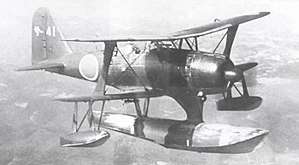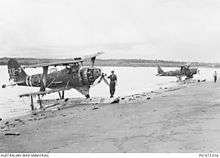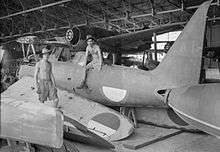Mitsubishi F1M
| F1M | |
|---|---|
 | |
| Mitsubishi F1M2 on patrol, c. 1943 | |
| Role | Reconnaissance float plane |
| Manufacturer | Mitsubishi |
| First flight | June 1936 |
| Introduction | 1941 |
| Primary user | Imperial Japanese Navy |
| Number built | 944 |
The Mitsubishi F1M (Allied reporting name "Pete") was a Japanese reconnaissance floatplane of World War II. It was the last biplane type of the Imperial Japanese Navy, with 944 built between 1936 and 1944. The Navy designation was "Type Zero Observation Seaplane" (零式水上観測機).
Design and development
In 1934, the Imperial Japanese Navy issued a specification to Mitsubishi, Aichi and Kawanishi for a replacement for its Nakajima E8N floatplanes, which were used for short-ranged reconnaissance and observation missions from the Navy's warships.[1] Mitsubishi's design, the Ka-17, given the short system designation F1M1 by the Japanese Navy, was a small all-metal biplane powered by a single Nakajima Hikari 1 radial engine rated at 610 kilowatts (820 hp), the same engine as used by Aichi's competing F1A. It had elliptical wings and great care had been taken to reduce drag, with the number of interplane struts and bracing wires minimised. The first of four F1M1s flew in June1936.[2][3]
While the F1M1 had better performance than the Aichi aircraft, it had poor stability both on the water and in the air, so the aircraft was redesigned to resolve these problems. The wings were redesigned, with straight tapered leading and training edges and rigged with greater dihedral, and the vertical fin and rudder were enlarged. The aircraft's floats were enlarged to increase buoyancy, and the Hikari engine was replaced by a 652 kilowatts (875 hp) Mitsubishi Zuisei 14-cylinder radial, giving better forward visibility. As modified, the aircraft's handling characteristics were greatly improved, and the modified aircraft was ordered into production as the Navy Type 0 Observation Seaplane Model 11 (rei-shiki kansokuki ichi-ichi-gata, Reikan in short), with the short designation F1M2.[4][5] 940 series aircraft were built in total (342 by Mitsubishi and 598 by Sasebo Arsenal and 21st Arsenal) in addition to 4 prototypes (older publications gave different numbers, though, like 1,118 or 1,016 in total).[notes 1]
The F1M2 had a maximum speed of 368 km/h (230 mph) and operating range of up to 1,072 km (670 mi) (when overloaded). It provided the Imperial Japanese Navy with a very versatile operations platform.
The F1M was armed with a maximum of three 7.7 mm (.303 in) machine guns (two fixed forward-firing and one flexible rear-firing) with provision for two 60 kg (132 lb) bombs.
Operational history

The F1M was originally built as a catapult-launched reconnaissance float plane, specializing in gunnery spotting. The "Pete" took on a number of local roles including convoy escort, bomber, anti-submarine, maritime patrol, rescue, transport, and anti-shipping strike; for example sinking Motor Torpedo Boat PT-34 on 9 April 1942. The type was also used as an area-defense fighter and engaged in aerial combat in the Aleutians, the Solomons and several other theaters. In the New Guinea front, it was often used in aerial combat with the Allied bombers and Allied fighters.
Variants
- F1M1 : Prototypes. Four built.
- F1M2 : Two-seat reconnaissance floatplane for the Imperial Japanese Navy.
- F1M2-K : Two-seat training version.
Operators

Specifications (F1M2)
Data from Japanese Aircraft of the Pacific War [6]
General characteristics
- Crew: two, pilot and rear gunner
- Length: 9.5 m (31 ft 2 in)
- Wingspan: 11 m (36 ft 1 in)
- Height: 4 m (13 ft 1½ in)
- Wing area: 29.5 m² (318 ft²)
- Empty weight: 1,928 kg (4,251 lb)
- Loaded weight: 2,550 kg (5,622 lb)
- Max. takeoff weight: 2,856 kg[7] (6,296 lb)
- Powerplant: 1 × Mitsubishi Zuisei 13 14-cylinder two-row radial engine, 653 kW (875 hp)
Performance
- Maximum speed: 370 km/h (200 kn, 230 mph) at 3,440 m (11,300 ft)
- Range: 740 km (400 nmi, 460 mi)
- Service ceiling: 9,440 m (30,970 ft)
- Wing loading: 86.3 kg/m² (17.7 lb/ft²)
- Power/mass: 257 W/kg (0.156 hp/lb)
- Climb to 5,000 m (16,404 ft): 9 min 36 sec
Armament
- Guns:
- 2 × fixed forward-firing 7.7 mm (.303 in) Type 97 aircraft machine guns
- 1 × flexible rearward-firing 7.7 mm (.303 in) Type 92 machine gun
- Bombs: 2 × 60 kg (132 lb) bombs (1 × 250 kg bomb for suicidal missions)[8]

See also
Aircraft of comparable role, configuration and era
Related lists
References
| Wikimedia Commons has media related to Mitsubishi F1M. |
External links
Notes
- ↑ Number of 940+4 is quoted by Wieliczko (2017), p. 19-21 (in Polish), as coming from newest Japanese research.
Bibliography
- Francillon, R.J. Japanese Aircraft of the Pacific War. London:Putnam, 1970. ISBN 0370000331.
- Green, William. War Planes of the Second World War, Volume Six: Floatplanes. London: Macdonald & Co., (Publishers) Ltd., 1962.
- Wieliczko, Leszek A. (2017). "Mitsubishi F1M (Pete)". Technika Wojskowa Historia (in Polish). No. Special 6(36)/2017. Magnum X.